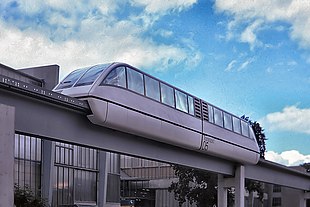
Back Transrapid Afrikaans Transrapid AST Transrapid BAR Transrapid Catalan Transrapid Czech Transrapid Danish Transrapid German Transrapid Spanish Transrapid Basque ترانسراپید Persian








Transrapid (German: [tʁansʁaˈpiːt] ) is a German-developed high-speed monorail train using magnetic levitation. Planning for the system started in the late 1960s, with a test facility in Emsland, Germany inaugurated in 1983.[1] In 1991, technical readiness for application was approved by the Deutsche Bundesbahn in cooperation with renowned universities.[2]
The last version, the 2007-built Transrapid 09, is designed for a cruising speed of 505 km/h (314 mph) and allows acceleration and deceleration of approximately 1 m/s2 (2.2 mph/s).
In 2002, the first commercial implementation was completed – the Shanghai Maglev Train, which connects the city of Shanghai's rapid transit network 30.5 km (18.95 mi) to Shanghai Pudong International Airport. The Transrapid system has not yet been deployed on a long-distance intercity line.
The system was developed and marketed by Siemens and ThyssenKrupp, as well as other, mostly German companies.
In 2006, a Transrapid train collided with a maintenance vehicle on the German test track, leading to 23 fatalities.
In 2011, the Emsland test track closed down when its operating license expired. In early 2012, demolition and reconversion of the entire Emsland site including the factory was approved, but has been delayed until late 2023 because of concepts for usage as a Hyperloop test track or a maglev track for the Chinese CRRC Maglev.[3][4]
- ^ "In sieben Jahrzehnten zur Schwebebahn". Der Spiegel (in German). 2006-09-22. Retrieved 2024-04-26.
- ^ Archived at Ghostarchive and the Wayback Machine: magermunson (17 January 2011). "Der Transrapid - Werbefilm ThyssenKrupp" – via YouTube.
- ^ "Transrapid-Teststrecke vor dem Abriss" (in German). 10 January 2012. Archived from the original on 6 July 2012. Retrieved 28 April 2022.
- ^ "Rückbau der Transrapid Versuchsanlage naht - MagnetBahn" (in German). 2023-06-26. Retrieved 2024-02-04.